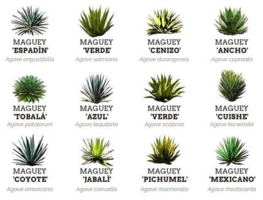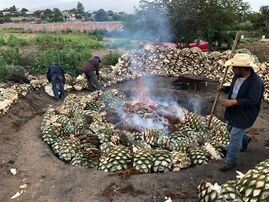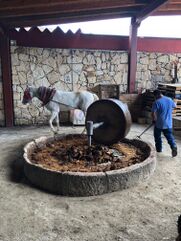Course:FNH200/Projects/2022/Processing and Packaging of Mezcal

Introduction
Mezcal is an alcoholic beverage originating from Mexico known for its smoky aroma and flavour [1]. There is a long process in the production of mezcal, going from cooking, crushing the agave and extracting the juice, fermenting, distillation, bottling, and aging [1]. Most of the information regarding the production process is often passed down to their next generation, so that they too can continue the business. Only 5 companies have legal permits in producing mezcal [2].
What Plant Is Used?

Mezcal is made from the maguey plant of the agave family, but there are more than 14 different species of the plant [1]. The main species used in the production of mezcal are Agave salmiana, Agave angustifolia, Agave cupreata, Agave esperrimia Jacobi, Agave webericela, Agave durangensis, and Agave potatorum [1]. These plants grow in most states in Mexico, however only certain states are legalized to produce mezcal including Oaxaca, Guerrero, Durango, Guanajuato, Michoacan, Puebla, San Luis Potosi, Tamaulipas, and Zacatecas [3]. Most of these plants grow in the wild, but to produce mezcal many Agave plants are farmed as well [3].
Harvesting and Cutting Agave
For most types of the Agave plant are determined to be harvested when they reach about 10 to 15 feet and the flower has sprouted [3]. The maturity of the Agave plant has a large variety, between 6 and 70 years and the plant grows from the inside out [3]. The leaves of the plants have thorns and are removed by using machetes before transporting the pina, the long bulb-like shape in the center of the plant to the distillery [4]. Removing the leaves makes it safer to carry and reduces the weight as some of the plants can weigh up to 80 to 200 pounds [4].
Cooking

There are 5 main steps: cooking, milling/extracting, fermenting, distilling, and aging [5]. The cooking process of mezcal is very similar to that of tequila; however, on a much smaller, artisanal scale.
Initially, the raw agave gets cooked in large holes or ovens in the ground. These are heated by hot stones and burning oak or mesquite wood [6]. Once the cooking process starts, the hole/oven is covered and left for a predetermined time based on the producer. The burning wood used to heat the ovens are the main contributors to mezcal's distinct flavour and aroma. This cooking also induces a Maillard reaction which aids with the flavour and smell [6]. By cooking the agave, it helps convert naturally occurring fructo-oligosaccharides to monosaccharides like fructose and glucose which will then ferment into ethanol [5][1]. This also helps prep the agave for the next step, extraction.
Crushing Agave and Extracting juice

Crushing the agave and extraction of juice is commonly performed in a mill [6].
Agave chunks are crushed, and are washed with hot water in several steps to extract the sugar-rich juice from the fibrous material. A new technological development is to use a diffuser to extract the carbohydrate-rich juice either from the raw or the cooked agave heart. Since cooking is a necessary step for fructan hydrolysis and flavour development, raw juice obtained by diffusers is cooked afterwards in retorts or heated tanks before fermentation, which is the next step in the process [6].
Fermenting
Fermentation of mezcal is done using the whole mash and put into special vessels [6]. These are usually made of leather or wood, but other materials are used depending on the region. A yeast starter is required and the type of yeast used in the fermentation depends on the producer. Different types of yeast contribute to different types of volatile compounds which contribute to the smell, while other yeasts are involved with ethanol production [6]. After some time, the alcohol content of the mezcal will inactivate the yeast, halting fermentation and allowing it to move on to the next step, distillation [6].
Distillation

Two distillation steps are carried out in the production of mezcal. Only a few more technified factories achieve the desired alcohol content in one step by using distillation columns or through a special still design [1]. The first distillation is called "ordinary" where the still is filled with equal parts of the liquid and fiber component from the fermentation tanks, obtaining 15-25% of ethanol [6] [1]. The second step is called "rectification" and it is achieved by distilling the obtained liquid again in either copper or clay pot stills, increasing the alcohol concentration to 45-50% of ethanol [1] [7]. During the entire process, the pot stills are frequently heated with wood, and some other ingredients can be added to the marcerate or extract to obtain flavoured mezcal [6] [8]. The clay pot stills are smaller than the copper stills, which hold about 100 litres, and are more common for use in rural areas. Mezcals from clay pot stills usually have an earthy character [7].
A special form of mezcal is called “Pechuga”, in which mezcal is usually distilled a third time, whereby fruits or nuts are added to the still or a raw, cleaned and skinned chicken breast is hung into it. Instead of a chicken breast, turkey breast, rabbit breast, venison and others can be used (“Pechuga” is derived after the Spanish name for “breast”). Some pechugas are made after the first distillation to increase the presence of the agave aromas in the distillate [7].
After distillations, mezcal can either be bottled or undergo aging process.
Bottling
Before bottling, mezcal is often stored and sealed in plastic containers to be tested for quality in the laboratory [7]. The final product which will be distributed is stored in glass bottles because it is non-reactive and is the universal packaging for liquor . Any other storage containers have the ability to destroy liquor aroma and flavour [9].

Aging
There are three different aging methods, creating three different final products:
- Reposado: Mezcal that is aged for 2-12 months in wooden barrels which have no restrictions on their size, shape, or capacity [7].
- Madurado envidrio: Mezcal that is aged for more than 12 months in a buried glass container [7].
- Anejo: Mezcal that is stored at least 12 months in wooden barrels with a maximum capacity of less than 1000 litres [7].
A common feature among the three aging methods is the requirement of minimal variations in light, temp, and humidity. This requirement is critical to better control the color, texture, and the flavour of mezcal.
Storage Instructions
The shelf life of mezcal is indefinite due to its high alcohol content and it should be stored properly to maximize the shelf life [10]. Unopened bottles of mezcal should be stored upright in a cool, dry place away from direct sunlight [11]. Once a bottle of mezcal is opened, the contents may begin to slowly evaporate and may lose some of its flavours, but it still remains safe to consume if it’s stored in a cool, dry, dark place with the lid on tightly [10] [11].
Although it has indefinite shelf life, it should be discarded if it develops an off odour, flavour, and/or appearance [10].
Final Product: Colour and Taste
The final taste of mezcal is quite vast, varying from sour to fresh and even fruity. Some consumers have described it having a smoky taste, which can removed via steam cooking the agave on purpose, since some don’t prefer the smoky taste [6]. If the mezcal is aged using wood, it then ends up adding a more oaky and vanilla taste to it [6]. The overall taste of mezcal is influenced by the type of agave species used, the region it’s cultivated in and when the plant is used during the production process [6].
The concluding colour of mezcal varies from colourless clear to a light amber colour [1]. This range of colours depends on the place of manufacture and the way it was aged, either with or without using oak wood [1]. Whether it's produced in Durango or Oaxaca, both final drinks will exhibit colours which slightly contrast one another, even if they are both aged the same way [1].
Fun Facts
- Mezcal originates 3000 years ago from the Aztecs [2].
- The oldest liquor in Latin America is considered Mezcal [2].
- Throughout generations, families of experts control the harvesting and production of mezcal who then pass that knowledge down through others [2].
- There aren’t many approved companies that are authorized in Mezcal production; about 5 companies in 9 states in Mexico [2].
Exam Question
How does mezcal get its alcohol content?
a. Maillard reaction
b. Fermentation of glucose into ethanol with the addition of a yeast starter
c. Fermentation of glucose into ethanol without the addition of a yeast starter
d. Ageing in wooden barrels
This question is relevant to Lesson 9 as part of microbial changes in fermentation. This question has a very clear, correct answer and is not too tricky. We feel like it’s on par with some of the other exam questions we have encountered. Both options A and D are processes that mezcal goes through; however, they do not produce alcohol. Option C is the opposite of the correct answer, but the reader needs to know that a yeast starter is required for alcohol in mezcal.
The process of fermenting glucose into ethanol with the addition of a yeast starter is a method of preservation that helps extend the shelf life of mezcal. Due to its high alcohol content, it is a shelf-stable product; it can be stored and consumed almost forever if storage instructions are properly followed.
It's also important for students to apply the concepts learned from Lesson 9 on how alcohol production occurs to that of mezcal and observe the similarities and differences, since we only learned the common alcohol drinks such as apple cider.
References
- ↑ 1.00 1.01 1.02 1.03 1.04 1.05 1.06 1.07 1.08 1.09 1.10 Nathiely Ramirez-Guzman, K (2019). "Traditional Fermented Beverages in Mexico". Fermented Beverages. 5: 605–635 – via Woodhead Publishing.
- ↑ 2.0 2.1 2.2 2.3 2.4 Jones, Carla (July 24, 2018). "16 Facts about Mezcal you Really Should Know". Stripey Spanish. Retrieved August 5, 2022.
- ↑ 3.0 3.1 3.2 3.3 Stratton, Mackenzie (July 27, 2021). "What is Mezcal". the spruce eats. Retrieved August 3, 2022.
- ↑ 4.0 4.1 "Agave Harvesting - How to Harvest Agave Nectar". Rosaluna. Retrieved August 3, 2022.
- ↑ 5.0 5.1 Leon-Rodriguez, Antonio (January 2008). "Optimization of fermentation conditions for the production of the mezcal from Agave salmiana using response surface methodology". Chemical Engineering and Processing: Process Intensification. 47: 76–82 – via Elsevier.
- ↑ 6.00 6.01 6.02 6.03 6.04 6.05 6.06 6.07 6.08 6.09 6.10 6.11 Villanueva-Rodriguez, S. (2012). "Tequila and mezcal: sensory attributes and sensory evaluation". Alcoholic Beverages: 359–378 – via Woodhead Publishing.
- ↑ 7.0 7.1 7.2 7.3 7.4 7.5 7.6 Zimmermann, Armin (April 23, 2017). "Mezcal. Part 5: Fermentation, distillation, maturation, the "worm"". Bar-Vademecum. Retrieved August 9, 2022.
- ↑ Arellano-Plaza, M. (March 21, 2022). "Mezcal Production in Mexico: Between Tradition and Commercial Exploitation". Frontiers in Sustainable Food Systems. 6: 10.
- ↑ Shipman, F. M. and Thomas, . Alan T. (November 29, 2021). distilled spirit. Encyclopedia Britannica. https://www.britannica.com/topic/distilled-spirit
- ↑ 10.0 10.1 10.2 "How long does Mezcal last? Opened and Unopened?". StillTasty. April 15, 2017. Retrieved August 9, 2022.
- ↑ 11.0 11.1 "Mezcal – All You Need to Know on How It's Made, Stored, and Bought". instacart. June 13, 2022. Retrieved August 9, 2022.